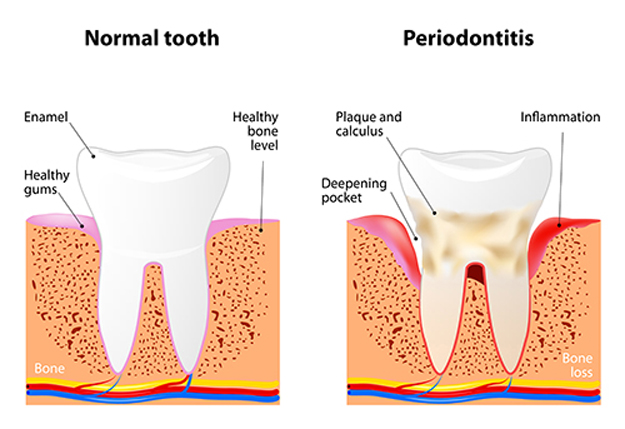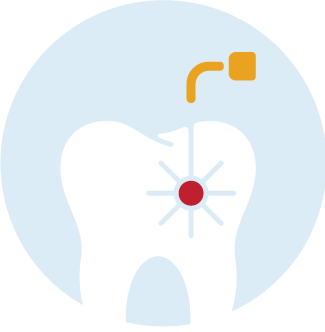
Gum and Periodontal Disease
Gum (periodontal) disease is an infection of the tissues that surround and support your teeth. Because gum disease is usually painless, you may not know you have it. Also referred to as periodontal disease, gum disease is caused by the bacteria that is constantly forming on our teeth.
Warning Signs that can Signal a Gum Disease Problem
Gums that bleed easily
Red, swollen, tender gums
Gums that have pulled away from the teeth
Persistent bad breath or bad taste
Permanent teeth that are loose or separating
Any change in the way your teeth fit together when you bite
Any change in the fit of partial dentures
There are many factors that increase the risk of developing gum disease, including: smoking, pregnancy, and diabetes. It is important to visit The Mugford Center if you suspect you have gum disease, because the sooner you treat it, the better.
The Early Stage of Gum Disease is Called Gingivitis
If you have gingivitis, your gums may become red, swollen and bleed easily. At this stage, the disease is still reversible and can usually be eliminated by a professional cleaning at your dental office, followed by daily brushing and flossing.
Advanced Gum Disease is Called Periodontitis

Chronic periodontitis can lead to the loss of tissue and bone that support the teeth and it may become more severe over time. If it does, your teeth will feel loose and start moving aro-und in your mouth. It usually gets worse slowly, but there can be periods of rapid progression.
Aggressive periodontitis is a highly destructive form of periodontal disease that occurs in patients who are otherwise healthy. Common features include rapid loss of tissue and bone, and may occur in localized areas or in the entire mouth. Periodontal disease cannot be cured; however, we have measures to help slow or stop the progression.
Research between systemic diseases and perio-dontal diseases is ongoing.
While a link is not conclusive, some studies indicate that severe gum disease may be associated with several other health conditions such as diabetes or stroke.
Regular dental checkups and periodontal examinations are very important. The treatment methods that our dentists diagnose will depend upon the type of disease and how far the condition has progressed. Good dental care at home is essential for helping to keep periodontal disease from becoming more serious.
The Early Stage of Gum Disease is Called Gingivitis
One major issue caused by periodontal disease is the formation of pockets in your gums. When your gums are healthy, the tissue fits snug around your teeth, sealing out bacteria. When your gums succumb to disease, this tissue begins to deteriorate and recede, forming pockets, gaps, in which bacteria can fall. Normally, these pockets and be kept clean by means of periodontal maintenance, or regularly scheduled deep cleanings of disease-ridden teeth and gums, but when they become too deep, their ability to be kept clear of bacteria becomes difficult, if not impossible, therefore requiring surgery.
Pocket Reduction Surgery
Pocket formation in the gums is cyclical. Bacteria causes pockets, which allows more bacteria in, worsening the pockets, which allows in even more bacteria. Pocket reduction surgery or osseous surgery puts an end to this cycle.
During this surgery, gum tissue is folded back, and bacteria are removed. Occasionally, damaged bone may need to be smoothed out to prevent hiding places for bacteria. The tissue is then secured back in place and allowed to heal.
Benefits of Pocket Reduction Surgery Include
Preventing damage from periodontal disease
Restoration of a healthy smile
Reduces bone loss
Prevents infections from spreading throughout the body
Helps make periodontal maintenance easier
Makes at home oral maintenance easier
If periodontal disease has wreaked havoc on your gums, causing pockets too deep to be cleaned by regular periodontal maintenance, pocket reduction surgery can help start the healing process.
Scaling and Root Planning
Scaling and root planning is a special type of treatment that goes deeper BELOW the gumline to remove contaminated debris and bacteria, most often performed on patients with active periodontitis.
This seems to be a procedure that causes much confusion for patients trying to understand the difference between “just a cleaning” and scaling and root planning, and the need/reason for this procedure.
A professional polishing or prophy removes only the soft sticky plaque and hard crusty calculus that is ABOVE the gumline on the crown of the tooth. Scaling and root planning is done to remove soft sticky plaque and hard crusty calculus that is loaded with bacteria, around and BELOW the gumline on root surfaces.
Scaling
Scaling is a procedure that meticulously removes contaminated biofilm, plaque, calculus, microorganisms, and toxins from around the gumline down to the bottom of each periodontal pocket, in order to obtain a healing response.
Root Planning
Root planning involves smoothing the root surfaces of your teeth with thin instruments so gum tissue can more firmly reattach to roots that are clean and smooth, to prevent tooth loss and sensitivity problems. This procedure makes it more difficult for plaque, calculus, and bacteria to accumulate along these root surfaces.
Because this procedure goes deeper than a regular cleaning, your mouth may be numbed. The cleaning may take one to six visits to complete. Depending on the extent of the disease, you may need one or more quadrants of the mouth to be treated with scaling and root planning.
SOME REASONS WHY ROOT PLANNING MAY BE NECESSARY
- To control the growth of harmful bacteria
- Help the pocket wall reattach firmly to the clean root surface
- Prevent further bleeding of the gums from disease
- Reduce inflammation
- Reduce discomfort
- Prevent bone loss
- Prevent gum disease related tooth loss
- Reduce systemic disease
HOME CARE AFTER ROOT PLANNING AND SCALING
Rinse with warm salt water every few hours (1/2 tsp. salt in 8 oz. water) for the remainder of the day to encourage healing and soothe discomfort. Be careful not to bite or chew your lip, cheek, or tongue while they are numb. Avoid chewing for 2 hours after this procedure or until the numbness has worn off. Keep your fingers and tongue away from the areas that have been treated. Take Tylenol or ibuprofen according to directions on the manufacturers’ label for a couple of days to help with the discomfort; do NOT take aspirin because it may prolong bleeding.
Rinse your mouth with Closys or Chlorohexidine, if prescribed by your dentist, to reduce oral bacteria. Do not smoke or chew tobacco for 72 hours after the procedure to allow for healing. Gently brush and floss your teeth after each meal. How you care for your teeth and gums at home after treatment is critical to reducing the risk of recurring periodontal disease.
Periodontal Maintenance
A periodontal maintenance procedure (PMP) is defined as a procedure that is recommended following periodontal treatment and continues at varying intervals, determined by the clinical evaluation of our doctors. These intervals can be as frequent as every two months and they can be extended as long as six months, depending on the patient. Keeping up your PMP interval is important because periodontal disease can recur without adequate follow-up. PMP includes removal of plaque and tartar above and below the gums, scaling and root planning of specific areas, and polishing. PMP is always completed following active treatment such as scaling and root planning or more extensive gum surgery.
Surgical Procedures
Oral surgery has vastly improved over the last few decades. Thanks to groundbreaking techniques and cutting-edge technology, our surgical options are safer, faster, and more effective than ever before. If you need oral surgery, you’ve come to the right place! The Mugford Center specializes in a variety of surgical procedures that will improve your oral health and the appearance of your smile.
Bone Grafting & Guided Tissue Regeneration
Successful implant treatment requires a sufficient amount of bone in the jaw. We may recommend a bone graft if your bone is too thin or too soft to support an implant. A graft can help restore deteriorated bone, and give you a second chance at implant treatment! if you have lost a tooth due to trauma or disease, we can restore or regenerate bone prior to the placement of bridges or implants. Guided Tissue Regeneration (GTR) refers to procedures that attempt to regenerate lost periodontal structures (bone, periodontal ligament, and connective tissue attachment) that support our teeth. This is accomplished using biocompatible membranes, often in combination with bone grafts and/or tissue stimulating proteins.
Tooth Extractions
Our wisdom teeth are not the only ones that can create problems. Some teeth can become impacted or infected due to eruption issues. Dr. Mugford may recommend a tooth extraction to help alleviate painful symptoms after other treatments have been exhausted.
Soft Tissue Grafts
Soft tissue grafting is also used to combat gum recession. The three most common types of soft tissue grafts include free gingival grafts, connective tissue grafts, and pedicle grafts. The type of soft tissue graft you need depends on the severity and location of your gum recession.
Crown Lengthening
Frenectomy & Fiberotomy
A frenectomy is a minor surgical procedure that involves the removal of the lingual or labial frenum. We may recommend a frenectomy to improve the mobility of your tongue and allow for proper speech (removal of lingual frenum). Removing the labial frenum may be necessary to close the gap between the two front teeth.
Orthodontic Tooth Uncovering
Orthodontic tooth uncovering is the process by which we first uncover a tooth that is either fully or partially buried beneath the gumline, and then move it into the proper position in your mouth. It is sometimes necessary to assist your teeth in their proper development and spacing and, although it may be unpleasant for a short while, it is highly preferable to leaving the tooth as it is.
BIOPSY & ORAL PATHOLOGY
Oral pathology refers to the diagnosis and study of problems that affect your oral and maxillofacial region. The goal of oral pathology is to cure oral diseases with causes that are not initially apparent. Once we determine the exact causes of a problem, we can develop a more precise treatment plan.
Ridge Augmentation
Sometimes, due to tooth loss or extraction, the bone underlying the gums will start to recede. This bone loss frequently results in the sinking of the ridge of the gums. Ridge augmentation is a great solution to the issue of unsightly pockets in the gums that can give bacteria a place to build up.
Gingivectomy
When a patient needs to have a portion of soft gum tissue, not bone, removed, this procedure is known as a gingivectomy, not crown lengthening. Excessive gum tissue can create flaps helping food debris and tartar to hide; our goal is to set our patients up for success with regular brushing and flossing, removing those flaps.
Sinus Lift
A dental implant needs a solid foundation of bone to support it, and bone loss is a common issue when teeth have been missing for a significant period of time. When bone loss occurs in the upper premolar or molar areas the sinus can fill in the gap left by the receding bone. No harm is caused by the sinus filling in the gap left by receding bone, but if dental implants are desired a sinus lift may be necessary.
Gum Contouring
Gum contouring is a cosmetic procedure that can change the shape of your gums. We can use this procedure to cut away excessive gum tissue that is giving you a “gummy” smile or to restore gum tissue that has receded and is now exposing too much of your teeth.
LANAP and Laser Gum Therapy

LANAP laser periodontal disease therapy is revolutionizing patient care and allowing patients to save their natural teeth, preventing the need for other interventions.
If you are like the millions of Americans who have gum disease, the major cause of tooth loss in adults, the LANAP laser Protocol may benefit you. The LANAP is a non-invasive laser gum surgery procedure, which can be a comfortable, no stitch approach to preserving your teeth.
You are probably not familiar with LANAP gum surgery using a laser. It is an amazing process that can help you heal your gums by treating the diseased gum tissue and cleaning the plaque off the roots of your teeth, so you restore your gum health. LANAP surgery is a much less invasive process than traditional gum surgery and your recovery time is amazingly fast. Many people leave and go straight to work. You will be able to chew in comfort and feel confident you are doing the best thing you can do to preserve your teeth.
Perioscopy
Perioscopy targets the areas below the gumline and into your jawbone where brushing and flossing miss. Perioscopy is a procedure that thoroughly cleans your gums and teeth. The procedure involves using a miniaturized tool called an endoscope that is inserted below the gumline and uses a tiny light and camera to send us a picture of the hidden pockets next to your tooth root. This lets us spot any trouble areas where bacteria are collecting and thoroughly clean the tooth root. During the procedure, we display a video feed on a monitor so you can see what we are doing.
Benefits of Perioscopy
It is minimally invasive, meaning that the experience is less traumatic to you, and recovery time will be much faster.
Perioscopy is significantly cheaper – sometimes costing as little as 1/3 of what other treatment options might cost.
Perioscopy can be less painful.
Because we are able to put a camera down under the gumline:
We can identify the bacterial pockets faster and avoid hitting the root of your tooth any more than necessary, decreasing the chances of you becoming overly sensitive in the tooth.
We can identify other dental conditions that might have been missed in the past, leading to better overall preventive dentistry.
